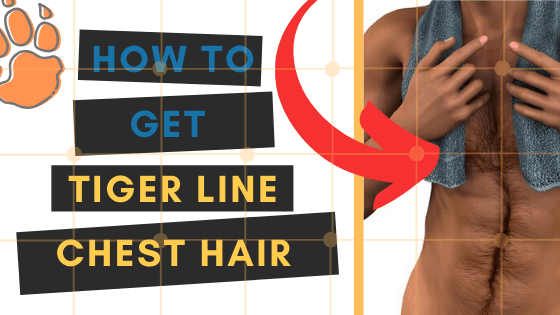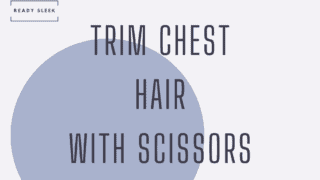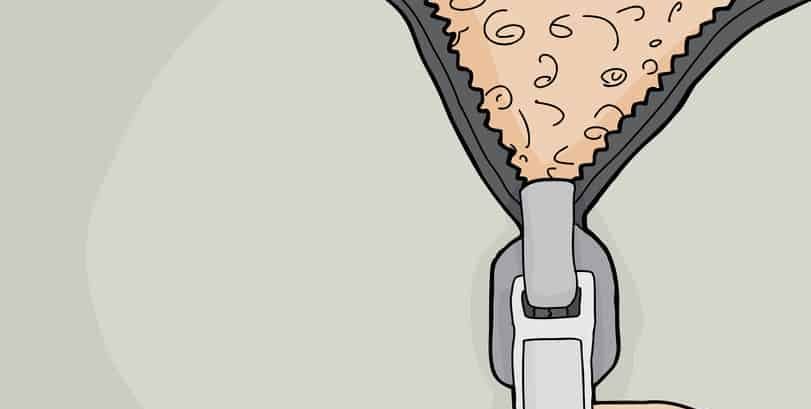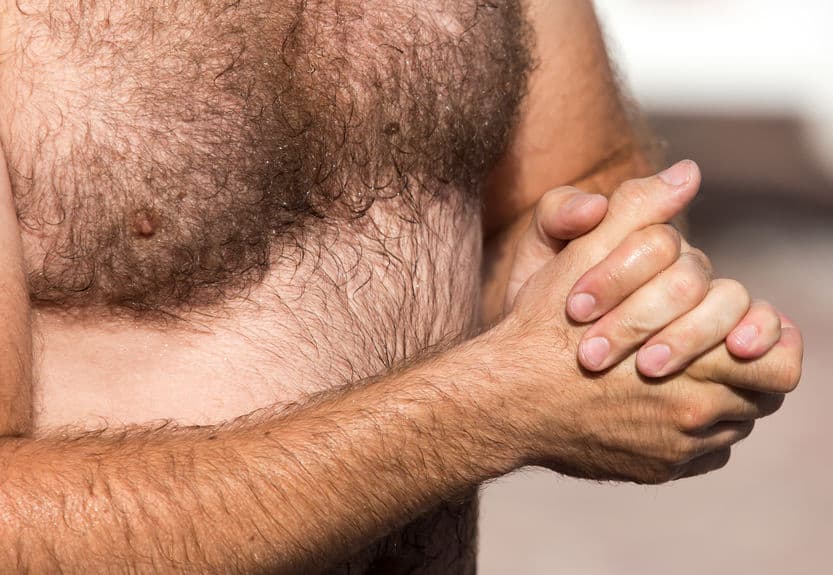Let’s face it. It isn’t the most comfortable sensation in the world. But the silky-smooth results keep men coming back for more. The less they have to do it though, the better. But how long does waxing chest hair last?
Six weeks is the average amount of time you can expect a waxed chest to last. There are certain factors that may cause this figure to vary. The proportion of “dormant” chest hair during the wax and the waxing techniques will play a role. But in general, six weeks is a safe bet.
That’s the answer in a nutshell, and it may be all that you wanted. But I wanted to dive a little deeper.
I’m going to explain why some men may notice regrowth faster than others, and what they can do to gradually increase the length of time needed between waxes.
Having a good understanding of this topic is important for managing expectations and being patient.
You’ll most likely be thrilled with the results – many men often are. But as with any grooming habit, results improve with experience and time.
Factors That Influence How Long Chest Waxing Lasts
Sure, it’s usually going to be around 6 weeks. But many men will notice some fine regrowth before this. There’s no exact answer for any one man, or with any one waxing session. Here are some reasons why.
1. Technique
It isn’t an easy job to do properly. There are plenty of DIY pre-made wax strips available in drugstores. Many beginners rush into buying them thinking the instruction leaflet will be good enough.
But they’ll often be disappointed. Professionals exist for a reason. That’s why I often advise that you get it done professionally a few times before you shift to DIY.
At least you’ll get an idea of what technique to use.
The main reason bad technique often reduces how long chest waxing lasts is that it leads to breakages mid-shaft. The beauty of good waxing is that it removes the hair at the root level. That’s what leads to long-lasting, smooth results.
But poor technique will just cause the hair strands to snap.
You may not notice snapped hair immediately after your waxing session. It may have snapped so short that it’s barely visible.
But once it grows a couple of millimeters longer, you’ll start to wonder why that chest wax you got was so short-lived.
Other “technical factors” which do play a role include the type of wax used, and the quality of the wax used. Again, the more professional the setting is, the better the know-how and the available tools. Just something to bear in mind.
2. Individual factors
This may seem unhelpful, but some men do just grow chest hair at a quicker rate. Genetics plays a huge role.
Although six weeks is generally considered the average, some men may notice their chest hair growing back much quicker. In much the same way, others may be slower.
If you’ve tried other chest hair removal methods already, you’ll probably have a good idea of how quickly your chest hair grows.
Unfortunately, this is one of those factors you have very little control over. The best course of action would be to focus on what you do have some control over.
That brings me to the next section quite nicely.
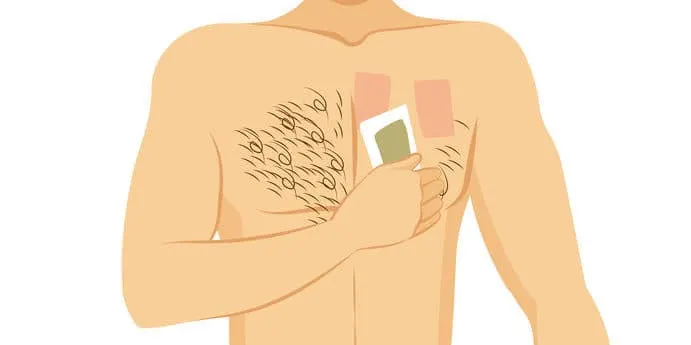
How To Make A Waxed Chest Last Longer
Let’s get to the good stuff. Ultimately, the objective is to increase the amount of time between chest waxes. Less pain, and less money – who would say no?
1. Do it often, then slow down
The first time you get your chest waxed will most likely be the worst. I mean that both in terms of the discomfort and the outcome.
As I mentioned earlier, the hair strands on your chest are in various different stages of the growth cycle.
Some of them are going to be dormant under the
But after two to three weeks, these hairs will start to grow and mature. Instead of waiting six weeks for the next waxing session, doing it after two to three weeks will allow you to pull those hairs out at the root-level too.
The point I’m trying to make is that doing it more frequently for the first few months will solve the problem of not catching those hairs in the early stages of growth.
Over time, you’ll be able to gradually increase the amount of time you’ll need in between waxes. You’ll stay smoother, for longer. You won’t notice chest stubble sprouting just a couple of weeks after your wax, because those hairs would have been dealt with long ago.
It may cost a little more to begin with, but after a few months, you’ll be having fewer sessions than you otherwise would have had.
So, you’ll be saving money in the long term and having to put up with fewer chest waxes as well.
2. Trim it down evenly, first
This is particularly relevant for your first chest wax. Or, you may have just let it grow long in between waxes.
Life gets in the way sometimes. Don’t worry, it doesn’t matter. The point here is this – if your chest hair is long, trimming it down before waxing is essential.
What I mean by “long”, is chest hair that’s longer than 1/4-inch. If it’s longer than that, there’s always a chance that the hair strand will break mid-shaft. But if it’s much shorter than that, the wax most likely won’t be able to grip.
That’s the ideal chest hair length for waxing.
Having your chest hair at a nice, uniform length before you wax is crucial to ensuring the result lasts as long as possible.
It will minimize the risk of breakages, and maximize the number of hairs the wax is able to grip onto.
Of course, there’s not much you can do about the dormant hairs. But having most of your chest hair even, and at the ideal length for waxing is very valuable.
2. Stick to professionals, at least at first
The technique is so crucially important. As I said earlier, getting it done professionally for the first couple of attempts is probably a good idea.
They do it every working day of their lives and they know what they’re doing. Plus, they will most likely have better wax, soothing toners, etc.
The experience will be more comfortable and the results will almost always be longer-lasting.
Once you’ve seen it done a few times, you may feel like you want to try DIY. At least you’ll be more knowledgeable, and the difficult first few sessions will have been handled by a professional.
3. Don’t give up
Just a quick tip to finish off with. Many men become frustrated by their first couple of waxing attempts. Whether it’s done DIY, or professionally, it isn’t comfortable.
Trimming and shaving just seem so much quicker, more efficient, and more comfortable. But try not to give up on waxing too soon.
If you do take it seriously and stick to this schedule, you’ll gradually notice that the time in between sessions becomes longer.
Does Chest Waxing Last Longer Than Trimming And Shaving?
Yes. The reason is that trimming and shaving don’t remove the chest hair at the root-level. They simply cut the hair above the level of the skin.
I’ve compared trimming with waxing and waxing with shaving more comprehensively in other articles.
But to summarize, I’d don’t recommend shaving because it’s itchy, irritating to the skin, and chest stubble never looks good.
Trimming is better but also has its downsides.
One of the main ways in which waxing beats both of these methods is its low maintenance requirements. You’d need to wax your chest a lot less than you’d need to trim or shave it.
Conclusion
There you have it. You now know, on average, how long chest waxing lasts. But in addition to that, you’ve got some tips on how you can make it last longer.
It might not feel like it at the time, but the silky smoothness of a waxed chest makes that discomfort worth it every time.
Ready Sleek founder. Obsessed with casual style and the minimalist approach to building a highly functional wardrobe. Also a fan of classic, vintage hairstyles.




